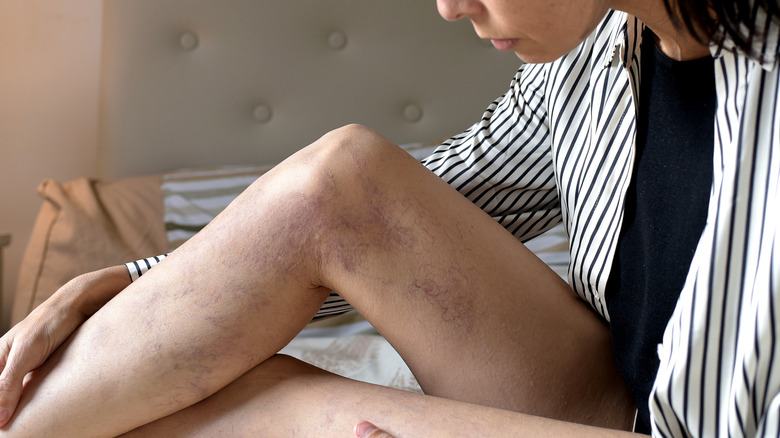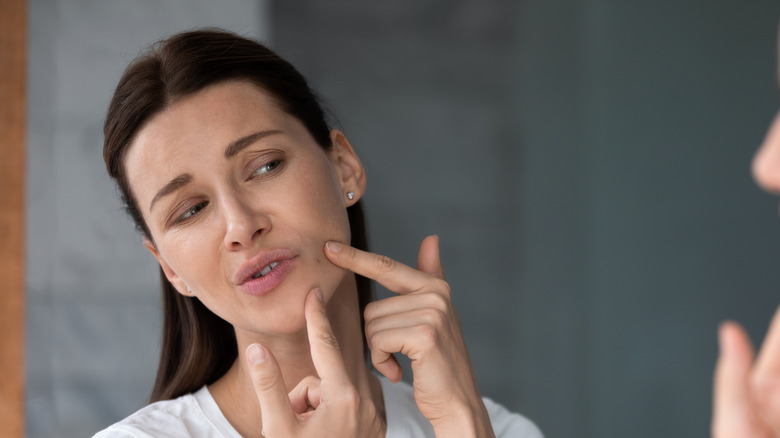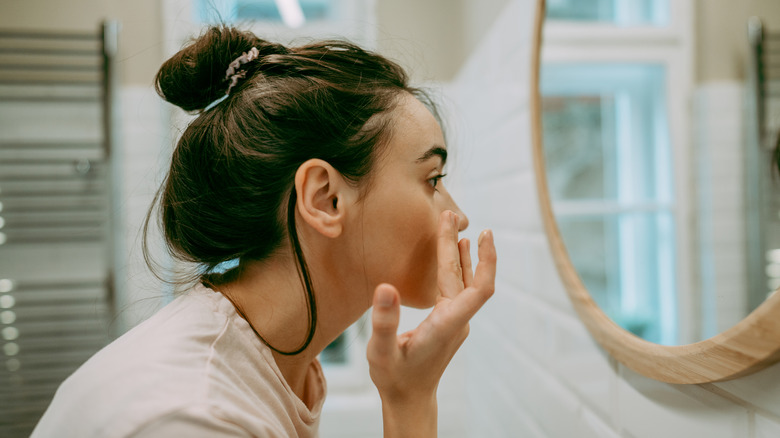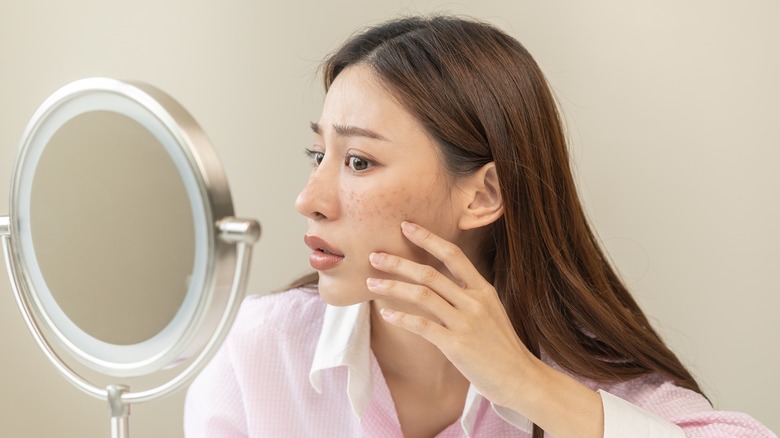11 Body Parts You Really Shouldn't Wax
No question about it: The wide world of hair removal is vast. You're spoiled for choice when it comes to determining the best method of stripping unwanted hair from your face and body. You can shave it away if you prefer. You can go the laser route if you seek a more permanent option. Alternatively, you could opt for waxing the hair if you want something that offers more permanence than shaving but, unlike laser hair removal, leaves the hair follicle where it is. That means the hair will eventually grow back, but at a slower pace than shaving.
What's great about waxing is that it leaves the skin smooth and hair-free. Regrowth is typically slow, making it a popular choice for everything from the bikini line and underarms to the eyebrows and upper lip. While it's great to have a reliable option available, it's equally important to understand that waxing isn't necessarily the right choice for removing hair from every part of the body.
That may come as something of a surprise, given that people have been known to wax virtually everything without issue — and it really may seem that almost no part of the body is off limits when it comes to waxing. Yet that's not entirely true, as experts say it's important to be mindful of waxing certain areas. Plus, people who have certain conditions, such as diabetes and dermatitis, may experience discomfort after waxing. Here's everything you should know to wax smarter.
Waxing nipples is a no-no
You don't have to "ask for a friend" — the truth is that nipple hair is incredibly common. Typically, that hair actually sprouts from the follicles on the areolae, but it can occur anywhere on the chest. Rina Allawh, MD, a dermatologist at Montgomery Dermatology LLC, explains to Healthline, "The thickness and texture of hair on the breast varies based on the individual, similar to facial and body hair."
That said, nipple hair usually has a wiry appearance and consistency. According to Allawh, "with age and hormonal changes, [it] may begin to grow thicker and coarser." While it's all very normal, that doesn't mean it needs to stick around if you just plain don't like it. Constance Chen, MD, a plastic surgeon, says that the trick is to "be careful around the delicate skin of the breast to not cause cuts, infections, or ingrown hairs."
Since waxing leaves the area temporarily raw, it could aggravate sensitive skin even more. Dr. Alyssa Dweck, MD, an ob-gyn, tells Shape that simple is best when it comes to removing the hair. "Plucking is probably the most common way to remove the hairs," she shares. And Mona Gohara, an associate clinical professor in the department of dermatology at Yale School of Medicine, tells Allure that it's best to take a cautious approach. "For shaving use a one or two-blade razor, go with not against the grain of the hair, and use shaving cream."
Now ear this: don't wax that ear hair
It may be tempting to wax the hair that's visibly peeking out of your ears, especially if you are self-conscious about it. First, a little science lesson. There are actually two different kinds of ear hair. One that just about everyone has is the very faint peach fuzz that may occur on the ear lobes and the outer ears, known as vellus hair. Its primary purpose is to regulate your body's temperature (that's why it's found all over the body).
The hair that's probably concerning you, though, is called tragi. It's darker, thicker, and far more noticeable than vellus hair, and it typically occurs within the exterior ear canal. For some people, that can be distressing, especially if the hair visibly sprouts out. So what's a hairy-eared person to do? Luckily, you have options, although waxing isn't one of them. It can be quite uncomfortable, and given that the ears are quite delicate, it's unlikely that you want to tempt the possibility of pain.
Instead, consider using an ear hair trimmer. These popular devices offer a painless approach that trims the hair down to a more manageable size, ensuring they aren't visible. Ear hair may not appeal to you, but it does play a role in safeguarding your inner ears from debris and germs. Trimming them down to size is a great way to ensure your ears still get the protection they need.
Never wax your eyelashes
The good news is that waxing eyelashes isn't a huge concern. Of course, in the interest of experimentation or curiosity, it's best to avoid attempting this method of hair removal. That's not to mention that most of the time, people seek effective ways of enhancing their lashes but aren't very interested in removing said hair.
Still, hot wax could drip onto your eyelashes while you're waxing your eyebrows and cause some serious drama. Yes, this situation has the potential to be just as tricky and challenging as it sounds. Wax hardens relatively quickly, so it's imperative to act fast to remove the wax — but not so hastily that you end up yanking out those lashes in the process. First, you can try to gently coax the wax off your lashes with your fingers. The key word is gentle. If this fails, relax the wax by applying a warm-to-hot washcloth to the affected lashes. Then dip a cotton swab in baby oil, apply it to the wax, and slowly rub it off.
A condition known as trichomegaly can occur in very rare cases, causing the eyelashes to grow especially long and thick. Some people may also notice that their lashes curl more intensely. In this case, it's advisable to simply trim the eyelashes to maintain a more reasonable and comfortable length.
Wax the pubic area with caution
Many people opt to remove hair from the pubic region. The hair does serve a protective purpose, trapping debris and preventing the spread of bacteria. While those are important benefits, the hair can cause discomfort. People may choose to remove it either because of that or purely for cosmetic reasons.
There are many different options for pubic area hair removal, from bikini waxes to Brazilian waxes. While it's not harmful per se, it can have significant side effects like rashes and discomfort. There are also some studies suggesting it can increase the risk of developing vulvodynia, per WebMD.
If you want to remove your pubic hair but would prefer to avoid the potentially disruptive side effects, consider one of the alternatives instead. For example, you could trim the hair with scissors, bringing it down to a length that is more manageable for you. That way, you'll still get the protective benefits of the hair, but at a length that is more tailored to your preferences. Hair removal creams, or depilatories, are also sometimes used to gently lift away the hair. Just be sure to use a formula that's safe to apply to the bikini area, and perform a test patch to ensure that you don't experience a reaction in response to any of the ingredients in the product.
Don't wax over an ingrown hair
Ingrown hairs occur when the hair essentially grows backward, burrowing under your skin and causing significant pain and inflammation. A bump may form as your body responds to the distress signal, and if it becomes infected, it may fill with pus and feel especially hot and angry to the touch.
Naturally, this is hardly the type of location where you might want to apply wax. That's because this action might disturb the affected hair follicle, aggravating it further and making the symptoms of your ingrown hair even more painful. It's always best to wait until the ingrown hair is completely resolved before you consider waxing over the area. If you are experiencing discomfort due to an ingrown hair, applying a warm compress to the affected area will draw blood to the area and may relieve some of your pain.
Once the ingrown hair is gone, you might want to consider alternative methods of hair removal, especially if you're prone to the problem. Laser hair removal may be a suitable option for some people, as the entire process targets the hair follicle directly to prevent future regrowth. Sugaring is an option that's more similar to waxing, but relies on a substance that is far easier on the skin than wax.
Steer clear of waxing over varicose veins
Varicose veins are enlarged veins that tend to sit near the surface of the skin. While they don't always cause pain, they can be uncomfortable for some people. In most cases, though, their presence is purely cosmetic. You may not even realize that this issue affects you until you notice that your veins appear especially dark blue or dark purple in tone. In some cases, the veins can bulge or take on a twisted appearance.
Once you're aware of them, it's important not to wax the skin where the veins are present. That's because the heated wax could cause more blood to flow to the area, thereby increasing your discomfort and potentially causing the veins to become even more engorged in response to the elevated temperature. Then there's the actual act of pulling the wax away from your skin. It's a disruptive process that could further traumatize the skin where varicose veins are present.
Shaving could also disturb the area, which is why it's best not to take a razor to the affected skin. Instead, consider laser hair removal. This is a safe choice largely because the laser doesn't make contact with the veins during treatment; instead, it's guided directly to the individual hair follicles. Lasers can also be used to treat varicose veins, something you may wish to consider if you're concerned about the way your varicose veins feel or look.
Don't wax over moles
Hairy moles have a bit of a reputation. Usually, their presence sets off alarm bells, as there's a widespread belief that a mole sprouting a hair could be cancerous. This, however, isn't the case. Dermatologist Apple A. Bodemer, MD, explains to Men's Health, "...moles with hair growing of them generally aren't cancerous. In fact, I have never personally seen a mole with hair that was abnormal."
While it's reassuring to hear that from someone who happens to see hairy moles on occasion, the appearance of said mole may be enough to have you glancing at the nearest tub of wax. It may be tempting to swiftly yank away the hair, but waxing may not always be the safest method of hair removal. The technique you choose depends largely on the appearance of the mole in question. If it's flat and sits against your skin, you can safely wax or shave the hair.
If the mole protrudes, however, avoid using wax (or a razor) over the skin. You can safely trim the hair as close to the skin as possible, ensuring that the hair is virtually invisible to the naked eye. If the hair bothers you and you'd like a more permanent option to remove it, you might consider visiting your dermatologist to have it removed. The process is relatively quick and can be performed as an outpatient procedure in the office.
Avoid waxing if you have a sunburn
Spending time soaking up the sunshine is a popular warm-weather pastime, but it can take its toll in the form of a raw, irritated, and uncomfortable sunburn. You know the signs: Your skin both looks and feels angry and scorched. Unfortunately, it can take some time to heal, and waxing the skin could aggravate any discomfort you already feel. That's why it's crucial to wait before removing the hair if that's the method you want to use. That goes for other hair removal methods, too, as disturbing the skin in any way could be unpleasant.
It's equally important to keep in mind some basic sun safety rules if you plan to wax. First and foremost, avoid waxing altogether before or after you spend time in the sunlight for at least 48 hours (longer if you're sunburned and healing, of course). In fact, exposing newly waxed skin to potent ultraviolet rays could increase your chances of developing a burn, so it's doubly important to avoid it. Waxing is basically a form of mild exfoliation, which could make your skin a bit more sensitive to the sun.
The bottom line, no matter what you plan to do regarding body hair: Make sure you're wearing a broad-spectrum sunscreen that protects your skin from both UVA and UVB rays. That way, you're protected both from sunburn and skin cancer — and you're less likely to experience a problem if you want to wax your skin, too.
Just say no to waxing if you're new to retinoids
Retinoids are great if you're in the market for an effective anti-aging routine that actually works. You simply can't go wrong with vitamin A, as it gently sloughs away old skin, promotes cellular turnover, smooths fine lines and wrinkles, and leaves your complexion looking vibrant. However, it can also increase your skin's sensitivity — and because it's a type of exfoliation itself, retinols can actually make your skin more vulnerable if it's waxed.
That's because waxing is also a type of exfoliation. Combine the two, and you have a recipe for considerable skin distress, and that can be hard to relieve once it happens. Dermatologist Craig Kraffert tells Allure that retinoids "contribute to increased skin fragility." He also recommends discontinuing any prescription retinol products for at least a week prior to any waxing sessions.
Dermatologist Tiffany L. Clay, MD, explains to Well+Good, "Retinoids decrease the thickness of the stratum corneum which is the outermost layer of the skin. If you are missing some of this protective layer, your skin may be damaged by the waxing process." She warns that waxing in this situation could even lead to scarring of the skin. Taking a patient approach and waxing only when you know you aren't going to be outside for extended periods is the most practical choice.
Don't wax if you have dermatitis
Issues like eczema and psoriasis can leave your skin chronically uncomfortable and irritated. If you have either of these or any other type of dermatitis, you know the symptoms of a flare-up very well: Your skin may feel hot and itchy, and it may flake and make you feel like you can't scratch the affected areas enough. Unfortunately, waxing the skin could have just as detrimental an impact on your skin as scratching it.
"Physical methods like shaving or waxing remove the surface layers of the skin, and chemical methods like using a depilatory can burn the skin," explains dermatologist Sheila Farhang, MD, to Everyday Health. If you absolutely have to remove the hair during a flare-up, though, keep in mind that you might be able to do so without disturbing the affected areas too much by shaving. The secret is to remove the hair slowly and methodically, using a razor with multiple blades for added comfort.
Always finish by moisturizing the area where you've removed the hair. Not only will this soothe freshly waxed skin, but it may also be comforting for spots that are affected by psoriasis, eczema, or another type of dermatitis.
Waxing may be off the table if you're diabetic
People with diabetes don't heal as easily, no matter what the source of the injury. While irritation from waxing isn't a type of "injury," it can cause very upsetting burns or cuts that may be especially difficult for a diabetic. Because skin that's waxed goes through a recovery process, there's a chance that a diabetic might experience slow healing or end up with chronic discomfort or damage as a result of the aggravation to the area. In fact, professionals at Wax and Beauty Bar advise diabetics to avoid waxing altogether because they're more vulnerable to developing infections.
So what's the solution if you're a diabetic with body hair who wants to remove it all (or at least some)? Many recommend laser hair removal, an option that targets the hair within the follicle to prevent regrowth. Some may also feel comfortable using cream depilatories, although be mindful of the odor and chemical content of the product you choose.












